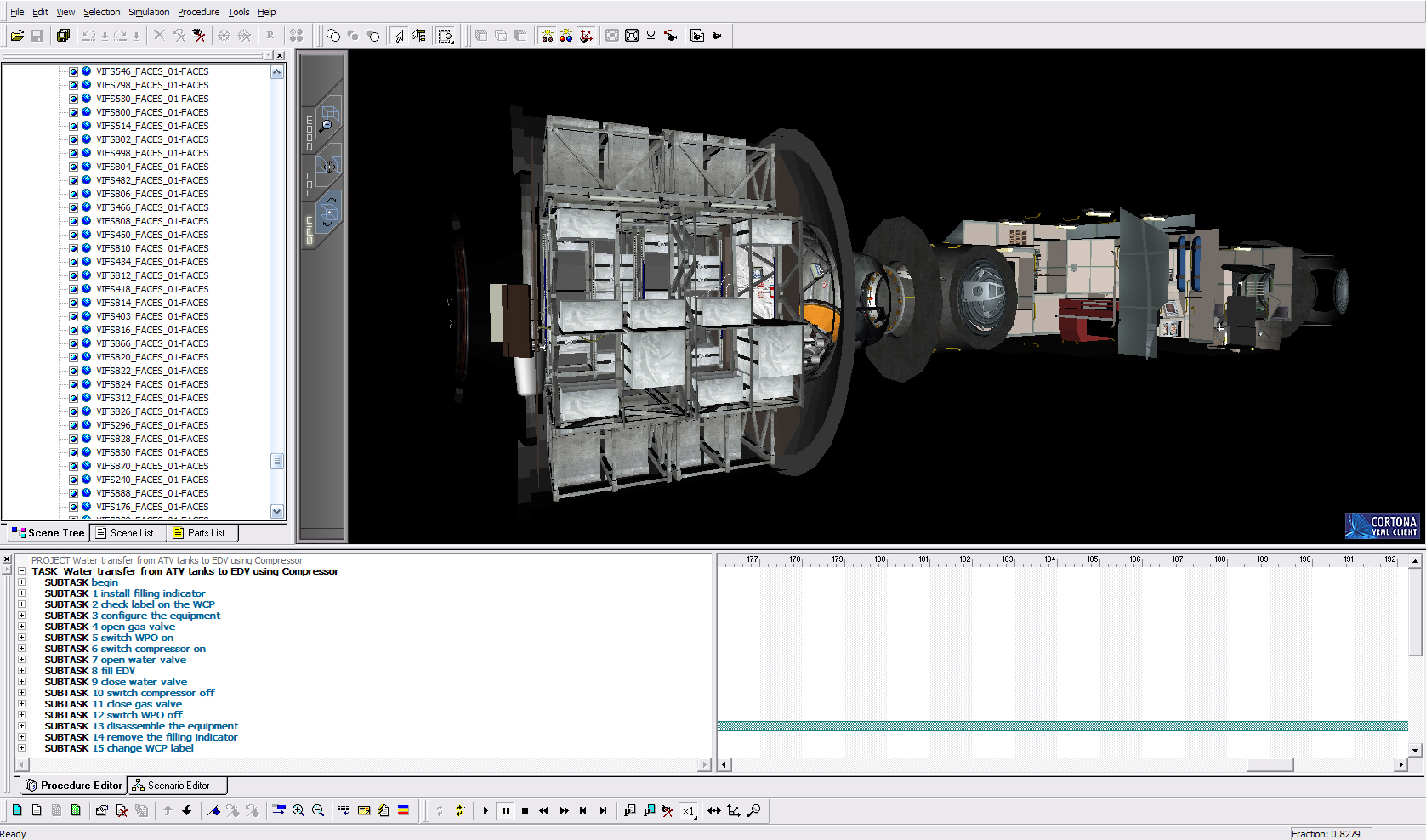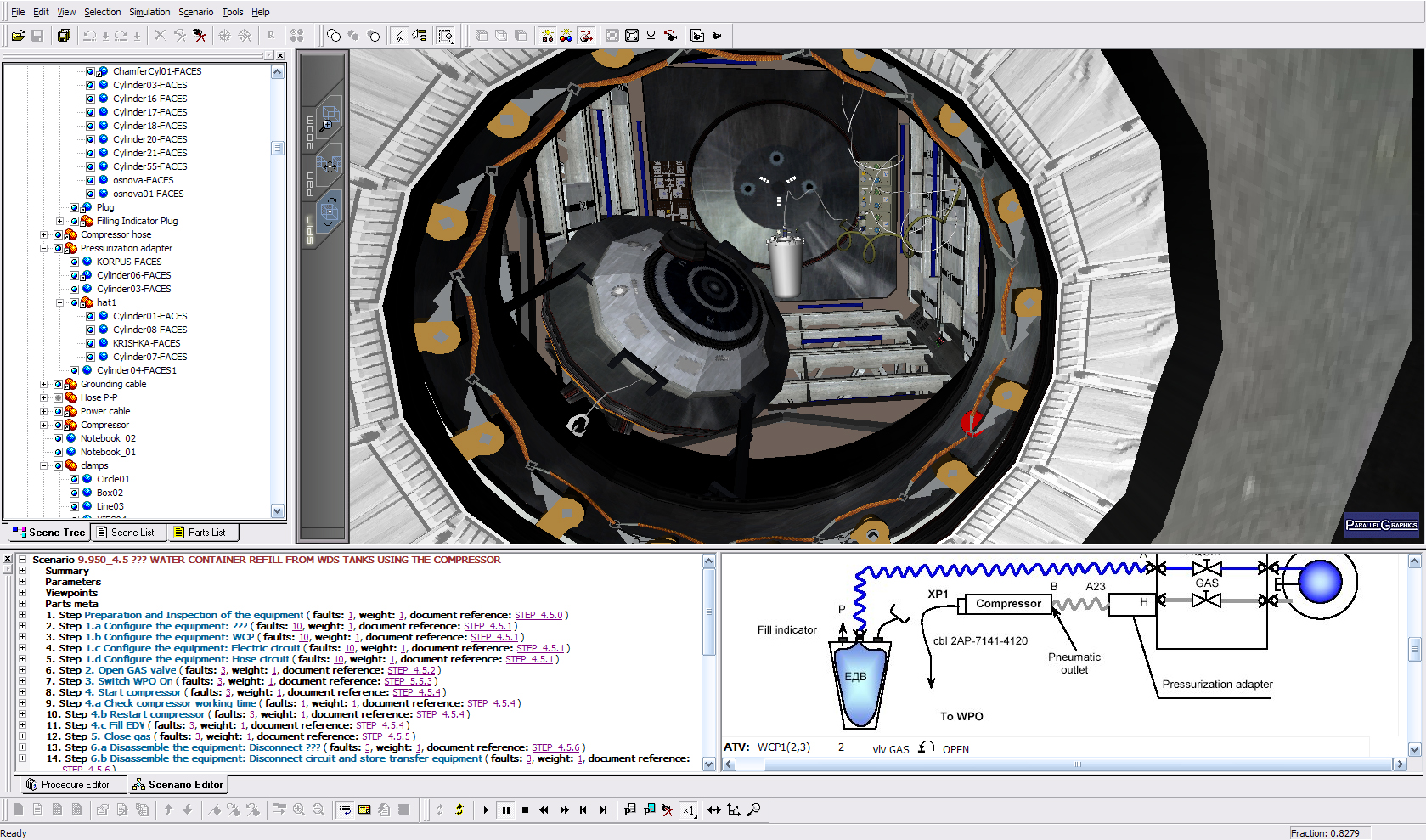

European Space Agency employs Cortona3D to speed training


European Space Agency employs Cortona3D three-dimensional, interactive animation to speed training
The European Space Agency (ESA) heads all major European space activities, including cooperation with other agencies to build and operate the International Space Station. Fail-safe astronaut training for the Automatic Transfer Vehicle (ATV) is pivotal for docking, bringing water and gas onboard, off-loading waste, and then undocking the craft.
To replace bulky, multilingual, old manuals, the latest 3D training technology from Cortona3D puts graphics, text, and interactive animations on one notebook PC screen. Astronauts more rapidly learn and memorize their many complicated hands-on, life-or-death procedures.
Space and ground personnel praise better learning speed, retention and can do just-in-time rehearsals in space. These factors increase the accuracy of results and mission safety.
Description
The European Space Agency comprises 17 member-states that jointly create dynamic programs of exploration and technology for satellite communication and navigation systems, Earth observation and meteorology, launchers, spaceflight and laboratories, exploration of the solar system, and deep space. Training prospective and seasoned astronauts and crew are vital.
Near Cologne, Germany, ESA’s European Astronaut Centre (EAC) trains, tests, and updates astronauts to ensure that theory and training become hands-on know-how. EAC trains astronauts from Russia, the USA, European countries, and Japan.
ESA’s International Space Station (ISS) was begun in 1998 and has been under continual construction. Jules Verne, the first Automated Transfer Vehicle (ATV) of many, launched on 8 March 2008, docked with the ISS on 3 April, and will undock August 2008.
This fleet of 20-ton space transport vehicles, which bring fresh food, water, oxygen, cargo, new experiments, and fuel to the ISS, requires delicate maneuvers performed by astronauts to dock (attach to the ISS), unload cargo, and take on trash and waste. Then the ATV becomes detached from the ISS and burns up as it reenters Earth’s atmosphere.
The challenge
Four years ago, training astronauts and ground crews were certain, safe, and slow. ESA required a more efficient solution for mission personnel to learn, practice, drill, and be examined on complex procedures. Yet no sacrifice in safety was acceptable.
Earlier training methods required pounds of annotated and cross-referenced manuals, often with parts in foreign languages. Some explanations were too terse or filled with unclear acronyms. And because no spaceflight will haul crates of manuals, months passed between study and in-space execution.
New training solutions had to cover the many control panels, tools, levers, valves, and racks of the ATV. It had to simulate complex tasks in zero-gravity with unfailing accuracy. A small misstep could cause loss of life, ruin millions of dollars of equipment, or waste years of work.
Computer-based training (CBT)
ESA surveyed the newest methods and tools to update and automate training. Cortona3D, an international leader in interactive 3D visual communication for equipment maintenance and training was selected for several reasons.
Cortona3D products can import and animate three-dimensional CAD, PLM, and other trusted drawings. Cortona3D RapidLearning is the tool used to create the training application. The software requires no programming knowledge to build courses, lessons, and graded examinations. In the final teaching product, text and highly interactive graphics display on the same screen.
Astronauts zoom in and out and rotate around the three-dimensional model while reading its documentation or parts list on-screen. They can follow lesson prompts, work independently, and see training procedures in continuous or step-by-step modes.
Compared to other CBT tools, this is much more visual, more interactive, and more conducive to retaining memories and new knowledge. When the astronaut must turn a given valve in the ATV, he sees that valve turn in his on-screen representation.
Richard MossATV Crew Instructor & Team Coordinator, ESA

Lessons, tests, industry standards
Training-industry research validates the learning benefits of three-dimensional animation to enhance Computer-Based Training (CBT). Test results can export to a learning management system (LMS) for review by teachers and students. Training simulations can be used within the LMS or exported to ADL, Giunti Labs’ Learn eXact, and other SCORM-compliant packages.
According to Moss, “ESA and EAC had the documents and knowledge. But it took Cortona3D software tools to transfer and combine our knowledge efficiently. The software’s interface made it simple to build new procedures that we could go back and change or evolve at any time. Making the final application required highly collaborative teamwork between Cortona3D and our teams. We went over each procedure to ensure factual accuracy, visual clarity, and ease of use.
This tool is very easy to use and that’s very important. Crews refresh a two-hour procedure in five minutes. It’s that intuitive.
Richard MossATV Crew Instructor & Team Coordinator, ESA
Students can practice wherever they have a PC loaded with the appropriate materials.

Benefits to date
By objective and subjective yardsticks, “It does everything we need,” says Moss, “and it has the power to do much more.”
Questionnaires that astronaut students filled out confirmed the improved speed of learning and better retention. “These professionals have seen every type of paper and CBT education you can imagine,” Moss says. “They are very tough and knowledgeable critics.
“They’re impressed by Cortona3D learning tools. You see their eyes light up and the questions start coming.”
“When you impress an astronaut,” points out Moss, “you have done something really special. They recognize the help this software will give them. It will save time and mistakes in an environment where errors cost lives.”
Better training worldwide
“There aren’t that many astronauts on the planet and they form a tight community,” says Moss. “Word has already spread to other space agencies and we expect to replicate the successes that EAC instructors and Cortona3D engineers have produced.
“They’re impressed with it and they’ll get a copy to take home to show teammates, trainees, and instructors,” he says.
Plans for the future
As the space community looks forward to a return to the moon and sending humans to Mars, it is clear that tools such as Cortona3D’s learning technology will be critical in ensuring the success of dangerous missions. Moss says the ESA may animate more procedures for a wider range of equipment, more-diverse payloads, modules, and experiments.
In theory, all critical space operations could someday be learned, drilled, and rehearsed in the safety of highly interactive animated simulation.
The European Space Agency (ESA) provides cooperation among the European States in space research and technology and their space applications for exclusively peaceful purposes. ESA takes part in the International Space Station. Its astronauts have participated in space flight missions since the early 1980s.
- RapidLearning
- In 2001, training contained materials in several languages. The in-orbit review was impractical with pounds of documents.
- Cortona3D’s new teaching techniques employ simultaneous reading, seeing, and manual skills to speed training and verify real-world, practical knowledge
- Interactive 3D training software speeds learning
- Astronauts laud effectiveness, safety improves
- Astronaut questionnaire showed that students learn faster, retain more
- Engineers base lessons on approved materials, then modify and animate
- Tests show areas of need, then export to SCORM-compliant software
- Astronauts can use portable PCs to review, rehearse in space, and verify steps as they work